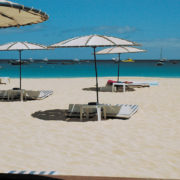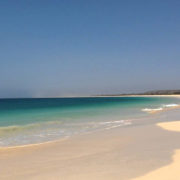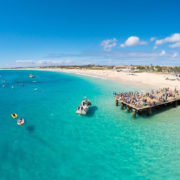Cape Verde is an archipelago made up of ten islands and eight islets. It is situated to the west coast of Africa, specifically 450 kilometres from Senegal, in the middle of the Atlantic Ocean. The strategic location of these Atlantic islands at the confluence of shipping routes between Europe, Africa and America, gave the islands of Cape Verde an important role in Portuguese expansion between the 15th and 17th centuries as a stopover on the trade routes for the provisioning of ships. The islands nowadays constitute a central point of sea and air traffic where most of the trade crossing the Atlantic converges.

The people are known for their extraordinary optimism and joie de vivre. The capeverdians are welcoming, with a passion for their music and dance, and manage to transmit this passion to their visitors.
The population, of Christian confession, is young: an average age of around 24, and the life expectancy goes beyond the age of 70.
Cape Verde already as four international airports, on the islands of Sal, San Vicente, Praia and Boa Vista which means access for holidaymakers who choose these paradisiacal islands for their holiday destination. Of all the islands, Sal offers the best tourist infrastructure, with the town Villa de Santa María and its beaches being most visited. Amongst all year round it is possible to practice windsurfing and kitesurfing at various points around the island. Sal has many tourist attractions, such as the salt flats, the fishing village of Palmeira and the Cave of Buracona.

The island of Boa Vista, the third largest of the archipelago, offers a surprising landscape of endless sand-dunes that, together with a number of oasis of palm trees, form a typical desert landscape, at the same time accompanied by extensive virgin beaches.
The island of Maio belongs to the southern group of islands. Its coastline is marked by the presence of many beaches of crystal-clear water, an unexplored wild paradise. It has the same geographical characteristics as the islands of Sal and Boa Vista, with extensive sand-dunes.
In San Vicente the most important port of the archipelago is found, Porto Grande, in Mindelo, the cultural capital of the country and home town of the diva Cesária Évora, one of the pioneers in spreading the music of Cape Verde on the international scene.
San Antonio is divided by an intensely beautiful mountain range, an ideal place to go trekking. With alpine vegetation, it has innumerable sugar-cane plantations and stills, where “grogue”, the national drink, is produced.
San Nicolás is characterised by the beauty of its mountain scenery. A typical leisure option in San Nicolás is to go sport-fishing.
Santiago, with the capital of the country, Praia, offers rugged scenery: the mountainous interior has lush vegetation, whilst the coastline is generally steep with black reefs and sparse vegetation. For lovers of night-life, Praia offers European-style bars and discotheques with an African flavour.
After gaining its Independence from Portugal in 1975, much to the joy and progress of its people, Cape Verde adopted a political, social and economic attitude that managed to overcome its lack of natural resources that could be economically exploited, with a geographically strategic position in the North Atlantic, stability and legislation-based security. Cape Verde has become a reference in Africa in the aspects of democratic stability, freedom of speech and civil rights. There is genuine trust in the future of the country. There is a glimpse of a horizon full of opportunities, investment, success and progress.

There is a glimpse of a horizon full of opportunities, investment, success and progress.
The parity of local currency with the euro was a decisive contribution to the stability of exchange rates, so important in a country with an unbalanced trade balance, dependent on the importation of consumer durables that will cover the need for new infrastructure capable of creating the conditions that will be attractive for foreign investors.
In January 2008, Cape Verde became the first Portuguese-speaking African state, and one of the few on the continent, to be classified as a Medium Developed Country (MDC) by decision of the Economic and Social Council (ESOSOC) of the United Nations. According to the Central Bank, this year will see the greatest economic growth of the decade.
In July 2008 Cape Verde acquired member status of the W.T.O. (World Trade Organisation), which enabled it to continue with its integration into the world economy.
Good macroeconomic management, together with good government over the past years have enabled the country to gain international credibility and have stimulated great interest in financial and tourism circles. The forecasts for the number of tourists growth each year. During 2016, Cape Verde received more than 640.000 tourists, principally in Sal and Boa Vista islands.
The expansion and improvement of the infrastructure of airports, ports and roads in the country are apriority for the government of Cabo Verde. The natural conditions, the proximity to large European centres for outgoing tourism, the political stability, the cultural uniformity and the cultural inclination of the people, the lack of epidemics, the security and institutional backup that for the investors are a guarantee that the rules of free trade will be respected, all of this attracts large-scale investments in tourism to Cape Verde.
The integration Cabo Verde into the world economy and the development of the private sector, backed up by the arrival of important groups of foreign investors, have led to the need to create a legal basis that not only offers attractive investment, but also provides a framework of security that will facilitate and guarantee businesses set up by foreign investors in the country.
The law guarantees the investor the transfer of currency out of the country in any amounts to which he is legally entitled as a result of correctly registered foreign investments transactions. The majority of investment is made on the islands of Sal, Boa Vista, Maio and San Vicente, as they have the best beaches. Nevertheless, in order to guarantee a long-lasting development in the economy and diversification of the fields of investment, programmes for the development of rural tourism are being defined for the islands of Santo Antão and Fogo, and commercial tourism for the island of Santiago.
Our urban developments in Cape Verde

Murdeira Master Plan - Island of Sal
Porto Murdeira Master Plan is located in the island of Sal, the most touristic island of Cape Verde. The project os located at only 10 kilometres fron the international airport of the island…

Sol Verde Residential - Island of Sal
Sol Verde Residencial is located in the south of Sal Island, the most touristic island of Cape Verde. The project is located just a few minutes to Santa Maria and only…

Atlantic Beach Resort - Island of Maio
Atlantic Beach Resort is located in the island of Maio – Cape Verde. It has a perfect location in the southwest part of the island and at only 10 minutes from the airport…










